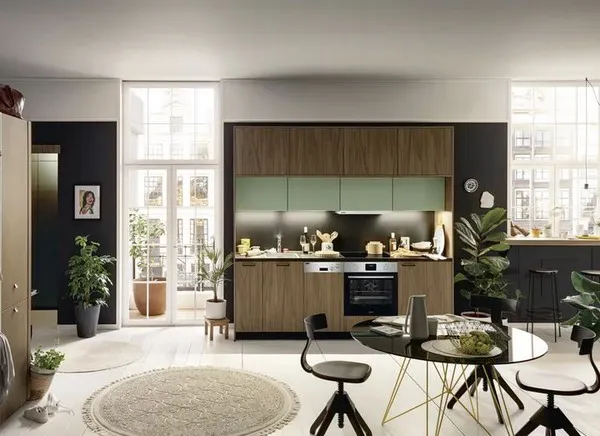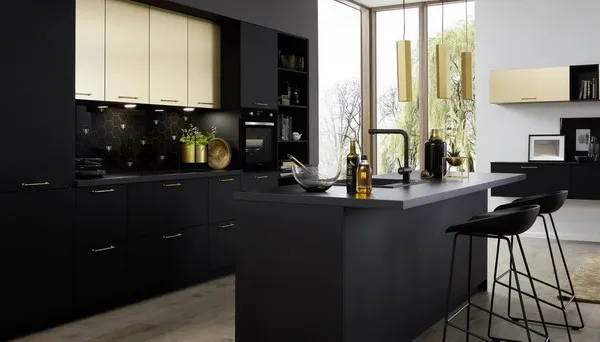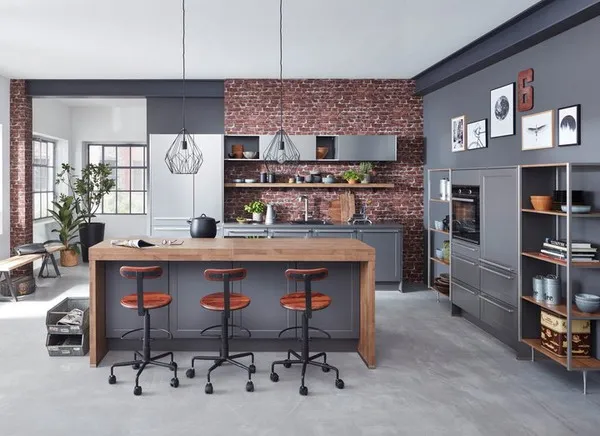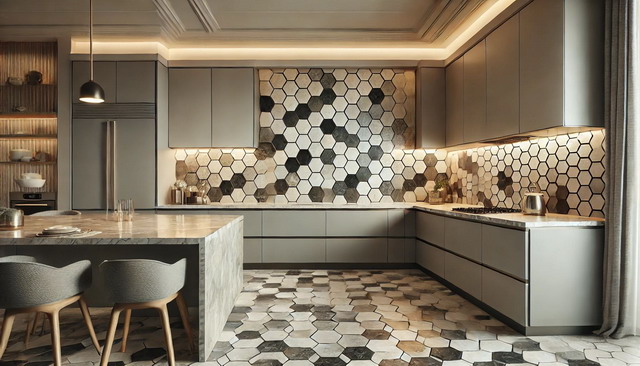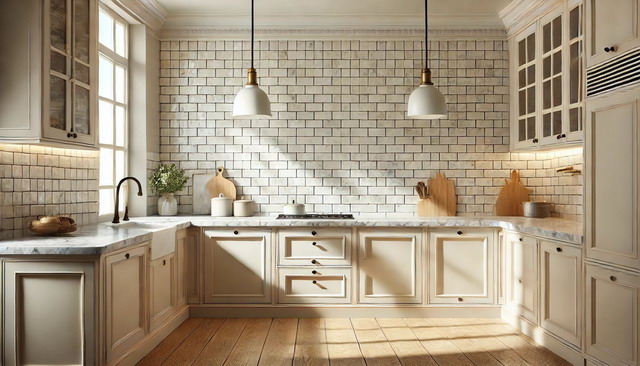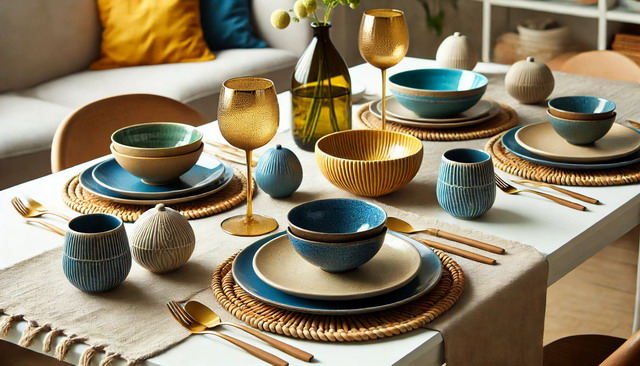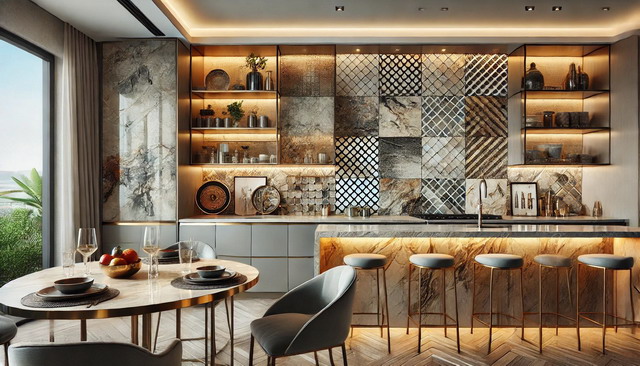Kitchen Trends 2025: Stylish Designs & Must-Have Features
Last Updated on September 14, 2024 by Mutiara
The kitchen has always been the heart of the home, but in 2025, it’s taking on a whole new identity. As lifestyles shift and technology advances, the modern kitchen is transforming into a space where sustainability, innovation, and aesthetics seamlessly converge. Homeowners are no longer content with kitchens that simply function; they want spaces that reflect their values, enhance their daily routines, and embrace the latest in design and technology.
From eco-friendly materials and smart appliances to multi-functional storage solutions and open-concept layouts, the kitchen trends of 2025 are reshaping how we think about this essential space. Kitchens are becoming smarter, more efficient, and more environmentally conscious, with a focus on maximizing both form and function. Whether it’s through sustainable materials, compact designs for smaller homes, or bold color palettes, the trends for 2025 are all about creating kitchens that cater to modern needs without compromising on style.
In this post, we’ll explore the key kitchen trends for 2025, diving into the latest innovations in materials, design, and technology that are shaping the future of the kitchen. Whether you’re planning a full kitchen remodel or simply looking for inspiration, these trends will help you create a space that’s not only beautiful but also built for the future.
Eco-Friendly Kitchen Materials for 2025: Sustainability at the Heart of Design
As we head into 2025, one of the most dominant trends reshaping kitchen design is the increasing demand for eco-friendly materials. With sustainability becoming more than just a buzzword, homeowners and designers alike are looking for ways to create beautiful, functional kitchens that have a minimal impact on the environment. Eco-friendly kitchen materials not only support greener living but also contribute to healthier indoor environments, making them a top priority for those remodeling or designing new kitchens.
Recycled Countertops: Beautiful and Sustainable
One of the most exciting trends in eco-friendly kitchen materials for 2025 is the use of recycled countertops. No longer are homeowners restricted to conventional granite or marble; today, the market is flooded with innovative options that reuse post-consumer waste, including glass, porcelain, and even paper.
Recycled glass countertops, for example, are made by repurposing glass from old windows, bottles, or even car windshields. This material is embedded in resin or concrete, creating stunning surfaces with unique patterns and colors. Not only do recycled glass countertops reduce the demand for virgin materials, but they also give homeowners the opportunity to create one-of-a-kind kitchen designs that are both stylish and sustainable.
Similarly, countertops made from recycled paper have gained popularity. Though it might seem unusual, these countertops are incredibly durable and lightweight, made by combining paper with a non-toxic resin. They offer a sleek, modern aesthetic and are perfect for those looking to minimize their environmental footprint without compromising on quality.
Bamboo Cabinets: A Fast-Growing Favorite
Bamboo, long celebrated for its rapid growth and renewable qualities, is emerging as a leading material for kitchen cabinetry in 2025. Unlike traditional hardwoods, which take decades to mature, bamboo can grow up to three feet in just a day and can be harvested within five to seven years. This makes it an extremely sustainable option for eco-conscious homeowners.
Bamboo cabinets offer more than just sustainability; they also bring a warm, natural feel to the kitchen space. Their light color and distinct grain patterns can be a striking contrast to other design elements, making them perfect for modern, minimalist kitchens. Bamboo is also incredibly durable, resistant to swelling and shrinking, and naturally anti-bacterial, making it an excellent choice for high-traffic areas like the kitchen.
In addition to its environmental benefits, bamboo cabinetry is often more affordable than traditional hardwoods, making it an attractive option for those on a budget. As more manufacturers adopt sustainable practices, bamboo’s popularity is expected to continue growing.
Sustainable Flooring: Cork and Reclaimed Wood Take Center Stage
Flooring is a crucial aspect of kitchen design, and in 2025, sustainability is playing a big role in the choices homeowners make. Cork and reclaimed wood are two eco-friendly materials that are making waves in kitchen flooring trends.
Cork is a particularly interesting material, harvested from the bark of the cork oak tree, which regenerates after harvesting. This means cork can be harvested without causing any harm to the tree, making it one of the most sustainable options available. Cork is also naturally resistant to water, mold, and insects, making it a durable choice for kitchens. Its soft, cushiony texture is easy on the feet and joints, providing added comfort for those who spend long hours cooking or entertaining.
Reclaimed wood is another flooring material gaining traction. By using wood salvaged from old buildings, barns, or industrial sites, homeowners can give new life to materials that might otherwise be discarded. Reclaimed wood offers a rustic, lived-in look that can add warmth and character to any kitchen, and since no new trees are cut down in the process, it’s a great way to reduce environmental impact. Each piece of reclaimed wood is unique, making every kitchen floor a work of art.
Low-VOC Paints and Finishes: A Healthier Home Environment
As we focus on sustainability, it’s important not to overlook the health aspect of eco-friendly kitchen design. Many traditional paints and finishes release volatile organic compounds (VOCs) into the air, which can cause respiratory issues, headaches, and other health problems. In response, low-VOC and zero-VOC paints and finishes are becoming the standard for kitchen cabinetry, walls, and trim in 2025.
Low-VOC paints contain fewer chemicals that can off-gas into the air, making them safer for indoor air quality. Many eco-conscious homeowners are now opting for low-VOC finishes not just for their walls but also for their cabinets and countertops, ensuring that their kitchens remain both beautiful and healthy.
These finishes are available in a wide range of colors and styles, meaning homeowners no longer have to compromise between sustainability and aesthetics. In 2025, expect to see more brands offering eco-friendly paints and stains, giving homeowners plenty of options to create the kitchen of their dreams without sacrificing their health or the planet.
Smart Kitchens: High-Tech Innovations for 2025
The kitchens of 2025 are not just eco-friendly but also smart. The integration of technology into kitchen design is transforming the way we cook, clean, and live, with high-tech innovations taking center stage.
AI-Powered Appliances: Efficiency Meets Intelligence
In 2025, AI-powered kitchen appliances are becoming more commonplace, offering unprecedented levels of convenience and efficiency. Smart ovens that can recognize what food you’re cooking and adjust temperatures automatically, refrigerators that monitor expiration dates, and dishwashers that optimize water usage based on load size—these innovations are designed to save time, reduce waste, and enhance the cooking experience.
Voice-controlled appliances, connected to platforms like Amazon Alexa or Google Assistant, are making kitchen tasks even easier. Imagine asking your oven to preheat while you’re still chopping vegetables or checking the contents of your fridge from your smartphone while grocery shopping. These conveniences are not only helping to streamline kitchen routines but also reducing energy consumption by ensuring appliances only run when needed.
Energy-Efficient Smart Tech: Reducing Waste
Sustainability continues to be a key driver in the development of kitchen technology, with many smart appliances designed to be energy-efficient. Smart refrigerators, for example, use sensors to regulate cooling, reducing energy waste, while smart lighting systems adjust brightness based on natural light levels, cutting down on electricity use.
Moreover, water-efficient dishwashers and faucets are being equipped with sensors that reduce water flow when not in use, addressing one of the biggest sources of waste in the kitchen. These eco-friendly, smart innovations not only make everyday tasks easier but also contribute to a more sustainable household.
This blend of eco-conscious materials and cutting-edge technology is defining the kitchen trends of 2025, creating spaces that are not only functional but also aligned with the principles of sustainability and efficiency. Whether through the use of recycled countertops, bamboo cabinetry, or smart, energy-saving appliances, the kitchens of the future are designed to meet the needs of both the planet and the modern homeowner.
Modern Kitchen Storage Solutions: Maximizing Space in 2025
In 2025, kitchen storage is no longer just about functionality—it’s about innovation, efficiency, and making the most of every inch of space. With kitchen sizes shrinking in urban areas and the growing demand for multi-functional homes, maximizing storage space has become a priority. The latest kitchen designs are embracing smarter, more creative storage solutions, transforming cluttered countertops and crowded cabinets into sleek, organized areas.
Hidden Compartments and Sleek Shelving Systems
Gone are the days of bulky, visible storage that clutters the kitchen’s aesthetic. In 2025, homeowners are looking for sleek, concealed storage solutions that keep their kitchens tidy and visually appealing. Hidden compartments are becoming a key feature in modern kitchen design. These smart solutions allow homeowners to store everything from small appliances to pantry items in concealed areas, maintaining a minimalist, streamlined look.
Pull-out shelving systems, for example, are becoming more sophisticated and customized. These shelves can be tucked away in narrow spaces, making use of every corner and crevice. From spice racks that slide out of slim gaps between cabinets to deep drawers with adjustable inserts for pots and pans, today’s storage solutions are designed to be flexible and easily accessible. Additionally, under-sink pull-out drawers are making it easier to store cleaning supplies and utensils in what was once an underutilized space.
Open shelving, another popular trend in kitchen storage, provides both form and function. Modern shelving systems allow homeowners to display aesthetically pleasing kitchenware, plants, or even cookbooks while keeping everyday items within reach. In 2025, expect to see more open shelving integrated into kitchen islands and upper walls, balancing visual interest with practicality.
Modular Cabinets and Multi-Functional Storage
Modular cabinetry is redefining kitchen storage in 2025. These flexible, customizable storage units are designed to evolve with a homeowner’s needs, making them ideal for kitchens that serve multiple functions. Modular cabinets can be rearranged, expanded, or reduced depending on the available space and storage requirements, offering homeowners greater control over their kitchen layout.
Multi-functional storage solutions are also on the rise. For instance, kitchen islands now often come with built-in storage, combining drawers, cabinets, and shelving into a single unit. Some even include pull-out chopping boards, trash bins, or additional counter space, making the kitchen island a versatile centerpiece of modern kitchen design. In smaller kitchens, this type of storage helps optimize space without compromising on utility.
As homeowners embrace more open-concept living spaces, the need for kitchens to serve multiple purposes is driving the demand for innovative storage solutions. From retractable countertops to foldable shelves, these adaptable designs are making kitchens more efficient, organized, and aesthetically pleasing.
Open-Concept Kitchens: The Seamless Transition of Living Spaces
Open-concept kitchens have been a rising trend for several years, and in 2025, they continue to evolve. As homeowners look to create more fluid and flexible living spaces, the kitchen is increasingly becoming a central hub for socializing, working, and dining. Open-concept kitchens, which blend seamlessly with adjacent living or dining areas, are transforming the way we think about space.
The Popularity of Open-Concept Design in 2025
One of the main reasons for the continued popularity of open-concept kitchens is the modern lifestyle’s emphasis on connectivity. Families spend more time together in shared spaces, and open kitchens allow for easier interaction, whether during meal prep, family gatherings, or casual hangouts. The design eliminates barriers between the kitchen and living areas, creating a more spacious, inviting atmosphere.
In 2025, homeowners are increasingly opting for open-concept kitchens that extend into their living rooms, dining areas, or even outdoor spaces. This seamless integration makes it easier to entertain guests, cook meals, and still be part of the conversation. It also creates a more cohesive design aesthetic, allowing for uniformity in color palettes, materials, and finishes across the kitchen and living areas.
Glass Partitions and Sliding Doors: Flexible Open Spaces
While the idea of an open-concept kitchen is attractive, there are times when homeowners may want the option to create a more private space. This is where innovative design elements like glass partitions and sliding doors come in. These flexible dividers allow homeowners to maintain the open feel of their kitchen while having the option to close it off when needed.
Glass partitions, for instance, are becoming increasingly popular in 2025 for those who want to maintain a visual connection between spaces without compromising on sound or smell. They offer a sense of openness and transparency while providing practical separation, making them a smart choice for kitchens adjacent to living rooms or home offices.
Similarly, sliding doors can be used to close off the kitchen when cooking or cleaning up, offering a flexible solution for those who appreciate the openness of the design but occasionally need more separation. These doors come in a variety of materials, from wood to frosted glass, allowing homeowners to choose a style that fits their overall aesthetic.
Sustainable Kitchen Lighting: Energy-Efficient Options for 2025
Lighting plays a crucial role in kitchen design, not only in terms of functionality but also ambiance and energy efficiency. In 2025, sustainable lighting solutions are taking center stage, with homeowners seeking energy-efficient, eco-friendly options that reduce their carbon footprint while enhancing the overall atmosphere of the space.
LED Lighting: The Go-To Sustainable Option
LED lighting continues to be the top choice for homeowners looking to reduce energy consumption without sacrificing style or brightness. LED bulbs use significantly less energy than traditional incandescent bulbs and have a much longer lifespan, making them an ideal solution for the environmentally conscious.
In 2025, expect to see more kitchens outfitted with LED lighting in various forms, from recessed lights to under-cabinet illumination. Under-cabinet LED strips are especially popular for task lighting, providing focused illumination for food preparation and cooking tasks without casting shadows. Pendant lights with LED bulbs over kitchen islands or dining areas also offer a stylish, energy-efficient alternative to more traditional lighting solutions.
Homeowners are also integrating smart lighting systems that allow for remote control and customization. With the ability to dim lights, adjust colors, and schedule on/off times through smartphone apps, these systems help reduce energy waste and create a personalized lighting experience tailored to specific tasks or moods.
Natural Light and Solar Solutions
Maximizing natural light is another sustainable trend gaining momentum in 2025. Designers are incorporating larger windows, skylights, and glass doors into kitchen designs to flood the space with natural sunlight, reducing the need for artificial lighting during the day. This not only creates a more inviting and uplifting environment but also helps homeowners lower their energy usage.
For those looking to take sustainability a step further, solar-powered kitchen lighting is becoming an increasingly viable option. Solar tubes, for example, capture sunlight and funnel it into the kitchen, providing natural, eco-friendly illumination. These solutions are especially popular in homes looking to minimize their reliance on traditional energy sources while still maintaining a well-lit kitchen.
Task Lighting for Efficiency
In 2025, task lighting is more focused and intentional. Homeowners are recognizing the importance of having different lighting zones for various activities. For example, cooking and prepping require bright, concentrated light, while dining or entertaining calls for softer, ambient lighting.
To address this, homeowners are installing a combination of overhead, under-cabinet, and pendant lights to create distinct lighting zones. These different types of lighting can be easily controlled, either manually or through smart home systems, to ensure the kitchen is well-lit for all purposes while maintaining energy efficiency.
The kitchen trends for 2025 are as much about sustainability and efficiency as they are about style and functionality. With a focus on creative storage solutions, open-concept designs, and sustainable lighting options, homeowners are increasingly prioritizing eco-conscious, flexible, and modern spaces that enhance both their lifestyle and the planet. Whether through hidden storage compartments or LED lighting, the kitchens of the future are designed to be smarter, more efficient, and more beautiful than ever before.
Compact Kitchen Designs: Maximizing Small Spaces in 2025
As urban living continues to grow, so does the need for kitchens that work within smaller spaces without sacrificing functionality or style. In 2025, compact kitchen designs are evolving to offer practical, space-saving solutions that still embody modern aesthetics and convenience. Homeowners and designers alike are reimagining how to make the most of small kitchens, blending creativity with efficiency to transform limited space into highly functional areas.
Foldable and Expandable Countertops: Multi-Functional Surfaces
One of the most significant trends for compact kitchens in 2025 is the rise of foldable and expandable countertops. These innovative surfaces can be tucked away when not in use, offering extra prep space only when needed. For example, homeowners can install a countertop that folds down from the wall or extends out from a kitchen island, providing a versatile solution for smaller kitchens.
Expandable countertops are particularly useful for homes with limited space for traditional kitchen islands. When not in use, these counters can be collapsed, creating more floor space for movement. This flexibility is especially important for compact kitchens, where every square foot counts. The trend toward multi-functional surfaces reflects the increasing need to balance functionality with space-saving design.
Space-Saving Appliances and Storage
Compact kitchens in 2025 are seeing a shift toward appliances that are both smaller and more powerful. Homeowners are choosing streamlined, space-saving appliances that can fit seamlessly into their kitchens without compromising performance. From slimline refrigerators to two-burner stovetops, these appliances are designed with efficiency in mind.
In addition to appliances, storage solutions in compact kitchens have become more innovative. Modular shelving systems, magnetic spice racks, and retractable shelves help maximize vertical space and keep countertops clutter-free. Even the undersides of cabinets are being utilized, with hanging storage systems that keep pots, pans, and utensils easily accessible while freeing up valuable drawer and counter space.
Compact kitchens are also benefiting from smart storage solutions that offer multiple functions in one unit. For example, a small kitchen island might include not only drawers and cabinets but also seating space and a built-in cooktop. These multi-purpose designs are perfect for compact kitchens, where space is at a premium and each element must serve more than one function.
Bright Colors and Reflective Surfaces for a Spacious Feel
Designers are using bright colors and reflective surfaces to make small kitchens feel larger and more open. In 2025, light shades such as soft pastels, whites, and light grays are becoming popular choices for compact kitchen designs, as they help to reflect natural and artificial light, creating a sense of spaciousness. Glossy cabinets, glass backsplashes, and metallic accents also contribute to the illusion of a larger space by reflecting light throughout the room.
By combining smart storage solutions with light colors and reflective surfaces, compact kitchens in 2025 are not only functional but also visually appealing, offering homeowners the best of both worlds.
Color Trends in Kitchen Design 2025: A Fresh Palette
The kitchen is the heart of the home, and in 2025, color trends are set to play a pivotal role in how this space feels and functions. Kitchen color trends in 2025 are all about balance—mixing calming, nature-inspired hues with bold accents to create an environment that is both inviting and dynamic. From earthy tones to vibrant pops of color, the kitchens of 2025 will be a canvas of creativity and style.
Earthy Neutrals and Calming Greens
Natural colors are leading the way in 2025, with many homeowners gravitating toward earthy tones and calming greens to create a soothing, grounded atmosphere in their kitchens. Shades like warm beige, soft taupe, muted olive, and sage green are becoming go-to options for cabinetry, walls, and backsplashes.
These colors evoke a sense of nature and tranquility, perfect for creating a serene cooking and dining space. Calming greens, in particular, are taking center stage, as they bring the outdoors in and pair well with natural wood and stone finishes. The earthy trend extends beyond just walls and cabinetry—expect to see these tones in countertops, backsplashes, and even kitchen islands.
Bold Accents: Pops of Color in Unexpected Places
While neutrals dominate the 2025 color palette, homeowners are also embracing the opportunity to add bold pops of color in key areas. Bold accent colors, such as deep navy, terracotta, and mustard yellow, are being used in unexpected places like kitchen islands, cabinetry hardware, and appliance finishes.
These accent colors add depth and personality to the kitchen, allowing homeowners to express their individual style. Kitchen designers are increasingly incorporating statement pieces like a bright backsplash or a colorful range hood to draw attention and break up the neutral palette. This mix of calming and bold colors creates a balanced yet dynamic look that brings warmth and character to the kitchen.
Two-Tone Cabinetry and Color Blocking
In 2025, two-tone cabinetry is continuing to grow in popularity. By combining two complementary or contrasting colors, homeowners can create a visually interesting kitchen space that feels modern and balanced. A common trend is to use a darker color on the lower cabinets and a lighter shade on the upper cabinets. This not only adds depth to the kitchen but also keeps the space feeling open and airy.
Color blocking is another trend gaining traction in 2025. This design technique involves using blocks of color to define different areas of the kitchen or highlight specific features. For example, a bold color might be used to accentuate the backsplash behind the stove, while the rest of the kitchen remains neutral. This approach allows homeowners to incorporate bold colors without overwhelming the space.
Sustainable Flooring Options for the Kitchen in 2025
When it comes to kitchen flooring in 2025, sustainability is front and center. Homeowners are increasingly choosing eco-friendly flooring options that not only look great but also have a minimal environmental impact. From natural materials to durable, long-lasting alternatives, sustainable flooring is redefining kitchen design.
Cork Flooring: Eco-Friendly and Comfortable
Cork flooring is one of the top sustainable choices for kitchens in 2025. Made from the bark of the cork oak tree, this material is harvested without harming the tree, making it one of the most eco-friendly options available. Cork is also naturally renewable, as the tree regenerates its bark over time, ensuring a continuous supply without deforestation.
In addition to its sustainability, cork flooring offers several practical benefits. It’s naturally resistant to water, mold, and mildew, making it ideal for kitchens where spills and moisture are common. Cork also has a soft, cushiony feel underfoot, which provides added comfort for those who spend long hours standing in the kitchen. This unique combination of sustainability, durability, and comfort makes cork a popular choice for eco-conscious homeowners.
Reclaimed Wood: Rustic Charm with an Eco-Conscious Twist
Reclaimed wood is another sustainable flooring option gaining traction in 2025. By repurposing wood from old buildings, barns, and factories, homeowners can give new life to materials that might otherwise end up in landfills. This practice not only reduces the demand for new wood but also adds character and history to the kitchen.
Reclaimed wood flooring offers a rustic, timeworn look that brings warmth and charm to any kitchen. Each plank has its own unique texture and patina, making reclaimed wood floors truly one-of-a-kind. While the aged appearance of reclaimed wood lends itself well to rustic and farmhouse-style kitchens, it can also be integrated into more modern designs for a striking contrast.
Waterproof and Durable Alternatives: Bamboo and Linoleum
Bamboo flooring continues to be a popular sustainable option in 2025, thanks to its fast-growing nature and durability. Unlike traditional hardwoods, bamboo is a grass that can be harvested every few years, making it one of the most renewable materials available. Bamboo flooring is also highly durable and resistant to moisture, making it a great choice for kitchens where spills and heavy foot traffic are common.
Another eco-friendly option is linoleum, which is making a comeback in 2025 due to its natural composition and longevity. Made from renewable materials like linseed oil, wood flour, and cork dust, linoleum is biodegradable and durable. Modern linoleum comes in a wide range of colors and patterns, offering a versatile and stylish alternative to synthetic flooring materials. Its water-resistant properties make it ideal for kitchens, and its natural composition makes it a top choice for those looking to minimize their environmental impact.
The kitchen trends of 2025 are driven by the desire for sustainability, functionality, and style. From compact kitchen designs that maximize space to vibrant color trends and eco-friendly flooring options, homeowners are increasingly embracing designs that reflect their values while enhancing the overall functionality of their kitchens. Whether you’re looking to create a compact yet efficient kitchen or incorporate sustainable materials, the trends of 2025 offer endless possibilities for creating a space that is both beautiful and environmentally responsible.
Multi-Functional Kitchen Islands for 2025: The Heart of Modern Kitchens
Kitchen islands have long been a favorite feature in kitchen design, but in 2025, they are evolving into true multi-functional workstations. Gone are the days when an island was simply a place for extra countertop space—today’s kitchen islands serve a multitude of purposes, from cooking and dining to storage and even entertainment. As open-concept kitchens continue to dominate, the island has become the focal point of the kitchen, combining form, function, and style in a single, central feature.
Built-in Appliances and Smart Features
In 2025, the kitchen island is more than just an additional surface—it’s a fully equipped workstation. Many modern islands come with built-in appliances, such as cooktops, ovens, wine coolers, or even dishwashers. This setup allows for a more streamlined cooking process, keeping everything within easy reach. It’s also a smart solution for kitchens with limited wall space, as homeowners can incorporate essential appliances into the island itself.
Smart technology is playing an increasingly important role in kitchen islands as well. Islands equipped with smart cooktops, touch-controlled faucets, and even charging stations for devices are becoming more common. This tech integration allows homeowners to control appliances with voice commands or smartphone apps, making the cooking experience more efficient and enjoyable. For example, smart ovens in kitchen islands can be programmed to start cooking dinner while you finish up prep work, all from the convenience of a connected app.
Seating and Dining Solutions
One of the biggest trends for 2025 is the island’s role as a dining space. In open-concept kitchens, the island often serves as a casual dining area, eliminating the need for a separate dining table. Many kitchen islands are now designed with built-in seating, allowing them to function as both a workspace and a social hub.
From breakfast bars to extended countertops that provide ample seating for family and guests, kitchen islands are evolving into multi-use dining spaces. Some designs even feature drop-down extensions or foldable tabletops that can be tucked away when not in use, offering flexibility in smaller kitchens.
This trend reflects the growing importance of the kitchen as a gathering place, where cooking, dining, and socializing happen in one integrated space. Whether it’s a casual family meal or entertaining guests, the kitchen island is the centerpiece of this social activity.
Extra Storage: Drawers, Shelves, and Cabinets
In 2025, kitchen islands are becoming storage powerhouses, with many designs incorporating drawers, shelves, and cabinets to maximize organization. Deep drawers for pots and pans, open shelving for cookbooks, and pull-out racks for utensils are just a few examples of how kitchen islands can provide practical storage solutions.
Some islands even feature hidden storage compartments, perfect for keeping appliances, gadgets, and ingredients out of sight but still easily accessible. This multi-functional approach to storage is especially valuable in smaller kitchens, where every inch of space needs to be optimized. By integrating storage directly into the island, homeowners can maintain a clean, uncluttered look without sacrificing functionality.
Sustainable Kitchen Countertops: Eco-Friendly Choices for 2025
Sustainability remains at the forefront of kitchen design in 2025, and when it comes to countertops, eco-friendly options are leading the charge. Homeowners are increasingly choosing materials that are not only durable and stylish but also kind to the environment. From recycled options to natural materials, the focus is on creating a kitchen that is both beautiful and sustainable.
Recycled Materials: Stylish and Eco-Friendly
One of the most popular trends in kitchen countertops for 2025 is the use of recycled materials. Countertops made from recycled glass, paper, and even aluminum are becoming common choices for eco-conscious homeowners. These materials offer a unique, modern look while reducing waste and conserving natural resources.
Recycled glass countertops, for example, are made from post-consumer glass products, such as bottles and windows. The glass is crushed and mixed with resin to create a smooth, durable surface. This material not only repurposes waste but also offers a striking aesthetic, with flecks of colored glass adding texture and visual interest.
Similarly, recycled paper countertops are gaining popularity due to their durability and sustainability. These countertops are made by compressing recycled paper with non-toxic resin, resulting in a smooth, hard surface that mimics the appearance of stone or wood. Recycled paper countertops are lightweight, eco-friendly, and available in a variety of colors, making them a versatile choice for modern kitchens.
Natural Stone Alternatives: Sustainable Quartz and Concrete
While natural stone countertops like granite and marble have long been popular, homeowners in 2025 are turning to more sustainable alternatives like quartz and concrete. Both materials are known for their durability and low environmental impact, making them ideal choices for those looking to reduce their carbon footprint.
Quartz countertops are engineered using a combination of natural quartz and resin, resulting in a highly durable, non-porous surface. Quartz requires less maintenance than traditional stone and is available in a wide range of colors and patterns, offering the look of natural stone without the environmental cost of quarrying.
Concrete countertops are another sustainable option gaining traction in 2025. Concrete is incredibly versatile, allowing for custom designs that can be shaped, colored, and textured to fit any kitchen style. When mixed with recycled materials or natural pigments, concrete countertops become even more eco-friendly, offering a modern, industrial aesthetic that appeals to homeowners looking for something unique.
Water-Saving Kitchen Fixtures: Eco-Conscious Choices for 2025
As sustainability continues to influence kitchen design, water-saving fixtures are becoming essential features in eco-friendly homes. In 2025, the focus is on reducing water consumption without sacrificing convenience or style. From smart faucets to eco-efficient dishwashers, kitchen fixtures are designed to conserve water while enhancing the overall kitchen experience.
Smart Faucets: Precision and Conservation
One of the biggest innovations in water-saving technology for 2025 is the smart faucet. These faucets use sensors to control water flow, ensuring that water is only used when needed. For example, smart faucets with motion sensors turn on and off automatically when you place your hands or dishes under the spout, reducing water waste during tasks like hand washing or rinsing produce.
Some smart faucets also allow homeowners to set precise water temperatures and flow rates, ensuring that water is not wasted while waiting for it to heat up or cool down. This technology not only conserves water but also enhances convenience, making kitchen tasks more efficient.
Voice-controlled faucets are another emerging trend, allowing homeowners to turn the water on or off with a simple voice command. These faucets are often integrated into smart home systems, giving homeowners complete control over water usage and ensuring that every drop is used efficiently.
Water-Efficient Dishwashers: Maximizing Cleaning with Less Water
In 2025, dishwashers are becoming more water-efficient than ever before. New models are designed to use significantly less water while still delivering powerful cleaning performance. Many water-efficient dishwashers now feature sensors that detect how dirty the dishes are and adjust the water usage accordingly, ensuring that only the necessary amount of water is used for each load.
These dishwashers also use advanced filtration systems to recycle and reuse water within the machine, further reducing overall consumption. By choosing a water-efficient dishwasher, homeowners can reduce their water usage by thousands of gallons each year, making a significant impact on both their utility bills and the environment.
Conclusion: Kitchen Trends Shaping the Future
As we look toward 2025, it’s clear that the kitchen is evolving into a space that combines sustainability, innovation, and style. From compact, multi-functional designs that maximize space to eco-friendly materials and smart technology that reduce environmental impact, the kitchens of the future are designed to meet the needs of both homeowners and the planet.
Sustainability is at the heart of these trends, with eco-friendly materials, energy-efficient appliances, and water-saving fixtures leading the way. At the same time, modern kitchens are becoming more functional and flexible, with designs that prioritize convenience, storage, and aesthetics.
Whether you’re remodeling your kitchen or building one from scratch, these trends offer a glimpse into the future of kitchen design. By embracing the latest innovations and sustainable practices, you can create a kitchen that not only looks beautiful but also enhances your lifestyle and reduces your environmental footprint.
